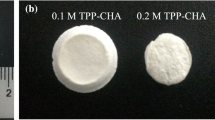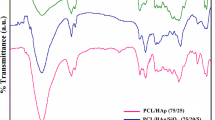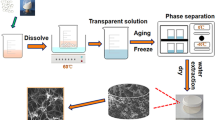Abstract
Nano biocomposite scaffolds of non-stoichiometric apatite (ns-AP) and poly(ε-caprolactone) (PCL) were prepared by a prototyping controlled process (PCP). The results show that the composite scaffolds with 40 wt% ns-AP contained open and well interconnected pores with a size of 400–500 μm, and exhibited a maximum porosity of 76%. The ns-AP particles were not completely embedded in PCL matrix while exposed on the composite surface, which might be useful for cell attachment and growth. Proliferation of MG63 cells was significantly better on the composite scaffolds with porosity of 76% than that those with porosity of 53%, indicating that the scaffolds with high porosity facilitated cell growth, and could promote cell proliferation. The composite scaffolds were implanted into rabbit thighbone defects to investigate the in vivo biocompatibility and osteogenesis. Radiological and histological examination confirmed that the new bony tissue had grown easily into the entire composite scaffold. The results suggest that the well-interconnected pores in the scaffolds might encourage cell proliferation, and migration to stimulate cell functions, thus enhancing bone formation in the scaffolds. This study shows that bioactive and biocompatible ns-AP/PCL composite scaffolds have potential applications in bone tissue engineering.








Similar content being viewed by others
References
Motskin M, Wright DM, Muller K, Kyle N, Gard TG, Porter AE, et al. Hydroxyapatite nano and microparticles: correlation of particle properties with cytotoxicity and biostability. Biomaterials. 2009;30:3307–17.
Zou Q, Li YB, Zhang L, Zuo Y, Li JF, Li JD. Antibiotic delivery system using nano-hydroxyapatite/chitosan bone cement consisting of berberine. J Biomed Mater Res A. 2009;89:1108–17.
Dorozhkin SV. Calcium orthophosphate-based biocomposites and hybrid biomaterials. J Mater Sci. 2009;44:2343–87.
Balasundaram G, Webster TJ. An overview of nano-polymers for orthopedic applications. Macromol Biosci. 2007;7:635–42.
Best SM, Porter AE, Thian ES, Huang J. Bioceramics: past, present and for the future. J Eur Ceram Soc. 2008;7:1319–27.
Shor L, Guceri S, Wen XJ, Gandhi M, Sun W. Fabrication and cell-matrix interaction study on three-dimensional polycaprolactone/hydroxyapatite tissue scaffolds. Biomaterials. 2007;28:5291–7.
Rhee SH, Choi JY, Kim HM. Preparation of a bioactive and degradable poly(epsilon-caprolactone)/silica hybrid through a sol-gel method. Biomaterials. 2002;23:4915–21.
Baker SC, Rohman G, Southgate J, Cameron NR. The relationship between the mechanical properties and cell behaviour on PLGA and PCL scaffolds for bladder tissue engineering. Biomaterials. 2009;30:1321–8.
Rhee SH. Effect of molecular weight of poly(epsilon-caprolactone) on interpenetrating network structure, apatite-forming ability, and degradability of poly(epsilon-caprolactone)/silica nano-hybrid materials. Biomaterials. 2003;24:1721–7.
Yeo A, Rai B, Sju E, Cheong JJ, Teoh SH. The degradation profile of novel, bioresorbable PCL-TCP scaffolds: an in vitro and in vivo study. J Biomed Mater Res A. 2008;84:208–18.
Aizawa M, Ueno H, Itatani K, Okada I. Syntheses of calcium-deficient apatite fibres by a homogeneous precipitation method and their characterizations. J Eur Ceram Soc. 2006;4–5:501–7.
Sachlos E, Gotora D, Czernuszka JT. Collagen scaffolds reinforced with biomimetic composite nano-sized carbonate-substituted hydroxyapatite crystals and shaped by rapid prototyping to contain internal microchannels. Tissue Eng. 2006;9:2479–87.
Kannan S, Pina S, Ferreira JMF. Formation of strontium-stabilized β-tricalcium phosphate from calcium-deficient apatite. J Am Ceram Soc. 2006;89(10):3277–80.
Mobini S, Javadpour J, Hosseinalipour M, Ghazi-Khansari M, Khavandi A, Rezaie HR. Synthesis and characterisation of gelatin-nano hydroxyapatite composite scaffolds for bone tissue engineering. Adv Appl Ceram. 2008;107(1):4–8.
Huang YX, Ren J, Chen C, Ren TB, Zhou XY. Preparation and properties of poly(lactide-co-glycolide) (PLGA)/nano-hydroxyapatite (NHA) scaffolds by thermally induced phase separation and rabbit MSCs culture on scaffolds. J Biomater Appl. 2008;22(5):409–32.
Jose MV, Thomas V, Johnson KT, Dean DR, Nyalro E. Aligned PLGA/HA nanofibrous nanocomposite scaffolds for bone tissue engineering. Acta Biomater. 2009;5(1):305–15.
Peltola SM, Melchels FPW, Grijpma DW, Kellomaki M. A review of rapid prototyping techniques for tissue engineering purposes. Ann Med. 2008;40:268–80.
Yousefi AM, Gauvin C, Sun L, DiRaddo RW, Fernandas J. Design and fabrication of 3D-plotted polymetric scaffolds in functional tissue engineering. Polym Eng Sci. 2007;47:608–18.
Cahill S, Lohfeld S, McHugh PE. Finite element predictions compared to experimental results for the effective modulus of bone tissue engineering scaffolds fabricated by selective laser sintering. J Mater Sci Mater Med. 2009;20:1255–62.
Ge ZG, Wang LS, Heng BC, Tian XF, Lu K, Fan VTW, et al. Proliferation and differentiation of human osteoblasts within 3D printed poly-lactic-co-glycolic acid scaffolds. J Biomater Appl. 2009;23:533–47.
Yuan H, Kurashina K, de Groot K, Zhang X. A preliminary study on osteoinduction of two kinds of calcium phosphate ceramics. Biomaterials. 1999;20:1799–806.
Nejati E, Mirzadeh H, Zandi M. Synthesis and characterization of nano-hydroxyapatite rods/poly(l-lactide acid) composite scaffolds for bone tissue engineering. Composites A. 2008;39(10):1589–96.
Zhang PB, Hong ZK, Yu T, Chen XS, Jing XB. In vivo mineralization and osteogenesis of nanocomposite scaffold of poly(lactide-co-glycolide) and hydroxyapatite surface-grafted with poly(l-lactide). Biomaterials. 2009;30:58–70.
Hong Z, Zhang P, He C, Qiu X, Liu A, Chen L. Nano-composite of poly(l-lactide) and surface grafted hydroxyapatite: mechanical properties and biocompatibility. Biomaterials. 2005;32:6296–304.
Zhu X, Eibl O, Scheideler L, Geis-Gerstorfer Jurgen J. Characterization of nano hydroxyapatite/collagen surfaces and cellular behaviors. Biomed Mater Res A. 2006;79(1):114–127.
Zhou DS, Zhao KB, Li Y, Cui FZ, Lee IS. Repair of segmental defecits with nano-hydroxyapatite/collagen/PLA composite combined with mesenchymal stem cells. J Bioact Compat Polym. 2006;5:373.
Khang D, Kim SY, Liu-Snyder P, Palmore GTR, Durbin SM, Webster TJ. Enhanced fibronectin adsorption on carbon nanotube/poly(carbonate) urethane: independent role of surface nano-roughness and associated surface energy. Biomaterials. 2007;28(32):4756–68.
Zhang LJ, Ramsaywack S, Fenniri H, Webster TJ. Enhanced osteoblast adhesion on self-assembled nanostructured hydrogel scaffolds. Tissue Eng A. 2008;14:1353–64.
Acknowledgements
The authors would like to thank Ms. Fan Minghui from Institute of Chemistry and Materials Science, University of Science and Technology of China for her assistance in material preparation of this paper.
Author information
Authors and Affiliations
Corresponding authors
Rights and permissions
About this article
Cite this article
Ye, L., Zeng, X., Li, H. et al. Fabrication and biocompatibility of nano non-stoichiometric apatite and poly(ε-caprolactone) composite scaffold by using prototyping controlled process. J Mater Sci: Mater Med 21, 753–760 (2010). https://doi.org/10.1007/s10856-009-3872-4
Received:
Accepted:
Published:
Issue Date:
DOI: https://doi.org/10.1007/s10856-009-3872-4




